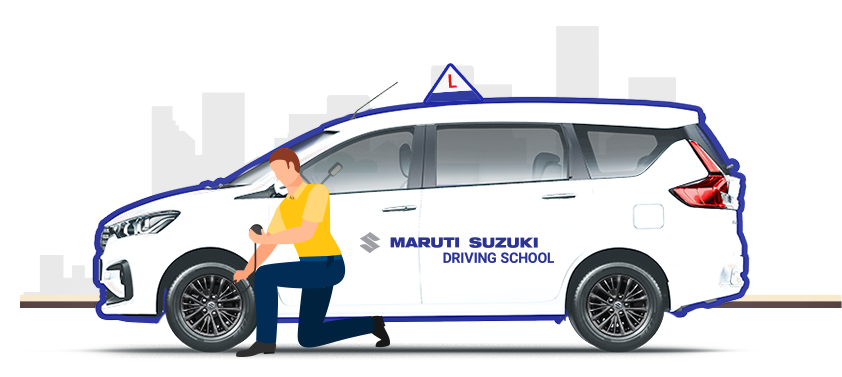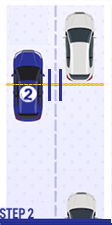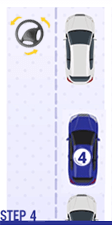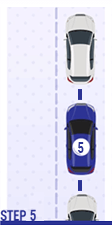Access blogs, quizzes, and the latest driving updates at your fingertips!

To begin with, let us look at the state of driving in India. Every year, around 1 50 000 people die due to road accidents, which is more than the number of people who have died in all the wars put together that India has fought. In comparison, the United States of America which is a developed auto market witnessed 40 000 road accident deaths in 2016. Out of 1 50 000 road accident fatalities, more than 25 000 deaths were due to car crashes. This is primarily because of negligent driving. More accidents are occurring due to wrong behavior than a lack of skills. Hence, controlling one’s behavior is as important a part of driving training as attaining driving skills.
Everyone on the road enjoys driving as much as you do. Roads are public property and it is extremely important that you drive safely. It is necessary to adhere to the traffic rules and maintain a safe distance between your car and other vehicles. Drive very carefully near schools, hospitals, and construction zones. Strictly adhere to the driving rules when you are near children, blind persons, handicapped individuals, and old people. Safe driving habits can reduce fuel consumption, decrease emissions, and reduce travel time too. Our collective behavior forms our road culture.
Driving conditions and traffic flow are factors that dictate your driving speed. While staying within the speed limit, you also need to match your driving speed with the traffic flow. The chances of crashing into vehicles in front of you increase if you drive faster than the traffic flow. Maintaining a steady speed, within legal limits, at a safe following distance will help give you the time required to handle an emergency situation. Constantly anticipating what may emerge on the road makes you a safe and responsible driver.
We love our technologically advanced cars and various driving assists that they come with, but with the advent of these technologies, drivers are becoming negligent too. At times, these tools divert the attention and lead to unsafe driving. Therefore, it is important to keep an eye on the road at all times and abide by the rules and regulations while driving. Never text while driving as it can endanger your life along with the lives of your co-passengers.
You must always practice everything that you learned for your four wheeler driving test. As it turns out, most of those rules aren’t just good driving lessons; they are legal regulations. It is better to follow traffic lights than get into an episode of road-rage. Make sure you are not talking on the phone while driving. And last but not least, never drive after consuming alcohol
It helps a great deal to understand the features of your car. As per the Motor Vehicles Act, a budding driver should understand the working of various systems of the vehicle so that the driver is able to take the correct decision in case of any abnormality observed or emergency situation faced. Exploring your own car is a sure-shot way to a happier driving experience. Learn to listen to your car and ensure that you have complete knowledge of all the controls and their functions. You will realize that a lot of this technical knowledge is not all that difficult to master.
Do a thorough safety check before starting a journey. Keep the checklist of the most important things ready, like seatbelts, mirrors, fuel, water, air pressure, first aid kit, spare tires, toolbox, spare bulbs and fuses, and an emergency parking reflector. Use the mirrors and signaling indicators to not only ensure your own safety but also the safety of other vehicles.
It is indeed never too late to check your driving skills and learn a few things afresh. Follow the pointers in this write-up and make your driving safer. Adhering to traffic rules, having a sound understanding of your vehicle, and socially responsible driving will keep you and your loved ones safe
If you get sweaty palms just thinking about parallel parking, trust us, you are not the only one. Many drivers feel the same pressure when they have to align and park the car without causing any damage to other cars.
Parallel car parking is a hard skill to master because of how intricate it is. And yet, it is an essential driving manoeuvre that you must know of to park in tight spaces that you encounter in day to day driving.
Here is all that you need to know about parallel parking, which along with the on-road practice, will help you master the art with ease.
Parallel parking is a method of parking a car in line with other parked vehicles on one side of the road and facing in the same direction as traffic on that side. To do this, one has to slightly drive past the available parking space and pull up next to the parked vehicle, then gradually reverse to fit in the space whilst keeping a safe distance.
This may sound a little tricky, but there is no need to get nervous. With concentration and some practice, one can easily master the technique of parallel car parking.
Being a precise driving manoeuvre, parallel parking hinges on following the right approach. Here are the four steps to parallel park your car.

In parallel parking, you should not just park in the very first space spotted. It requires careful analysis of the available parking space to see if your car will fit there. As a thumb rule, the parking space should be one and a half times the length of your car. Only then should you pull up or else keep looking until a suitable space is available. Once the right spot is found, stop your car parallel to the car you are going to park behind. Maintain a distance of 2-3 feet while doing so.

Next, slowly reverse until the middle part of your car is parallel to the other vehicle's rear bumper. At this point, your car will start changing direction to slot behind the car in front. The benefit of maintaining distance will become evident here; you'll have enough space to reverse without risking any contact between your car and the other vehicle.


Now, cut the steering wheel towards the right to achieve a 45° angle and continue in reverse gear. Then, turn the steering wheel anti-clockwise and continue reversing until your car is perfectly aligned with the rest of the vehicles, and parallel to the wall or divider on the driver's side.
Note: The same approach will be applicable when you are parallel parking your car on the left. In this case, the left side of your car will be parallel to the wall, divider or any such boundary.

The final step is to check if your car is at an equal distance from the cars in front and behind, and the edge of the road. If not, then reposition your car until it is in the center and demonstrates perfectly parallel lines.
Is it surprising for you to see other drivers flawlessly parallel park their car? Here are the 5 must-know parallel parking tips to help you get there.
Always keep your indicator (whether left or right) switched on while you are parallel parking the car to let other drivers know about your intended turn. Remember that this is the only way to communicate with other vehicles on the road. Hence, use your indicators wisely while parallel parking your car.
There are quite a few possibilities of blind spots when parallel parking. Hence, always keep an eye on both using your IRVM (Inside Rear View Mirror) and ORVMs (Outside Rear View Mirror) to check for any risks or obstacles while reversing the car.
Rushing is never a good idea on the road especially when parallel parking. Keeping in line with the thought, slowly and gradually reverse your car as you slot your car into the empty parking space.
Parallel parking is all about how swiftly and smartly you turn the steering wheel whilst having full control of it. Remember to place your hands in the nine and three-position at all times and let the wheel spin freely with both your hands on it as much as possible to maintain good control.
While keeping your car as close to the wall or divider as possible, you also need to ensure that there's ample room left in front and behind for other vehicles to easily pull in and out of their respective parking spaces without the risk of damage.
When the divider or wall is on the driver side while parallel parking, leave enough room for the right side doors to open for you and your co-passengers to get in and out.
Remember, the more you practice using these tips to parallel park, the easier it becomes to master the art without any sweaty palms or the risk of bumping into other parked cars while you are parallel parking your car.
There’s no age for learning, and the scope of learning is always infinite.
When it comes to driving a car, there are certain driving tips for beginners that work equally well for experienced drivers. In order to drive safely and responsibly, it is imperative that you follow the best driving practices – it is beneficial for you, other drivers around you, and the pedestrians on the road.
No matter how seasoned a driver you are, there is always some room for improvement. Here are some simple yet important car driving tips that will help make you a better driver: -
This is one of the most important driving tips that many people, especially beginners, tend to completely ignore. It is extremely important that you position your seat in such a way that you can comfortably operate the pedals, the gear lever, and the steering. At the same time, the seat must be angled in a manner wherein your thighs or back do not get strained.
There is a science behind holding a steering wheel correctly. But, let’s just talk about the thumb rule here. The thumb rule is to hold the steering wheel by placing your hands on 10 and 2 o’clock positions (like in a clock).
Horns and indicators are the two sources of communication that you have with the drivers around you at the time of driving. Both of these must be used liberally and smartly whenever required. Generally, horns are meant to be used for alerting the other cars about your presence.
*A lot of people have the habit of honking the horn profusely at signals or slow-moving traffic to communicate to the car drivers ahead to move faster. It is a wrong practice which should be avoided.*
When you are turning, make sure you use the turn indicators. Even at the time of changing lanes, make sure to use your indicators in the direction of the lane you are moving into. This is one of the most important car driving tips for beginners as well as people who have been driving for years.
While driving in traffic or on the highways, maintain a safe distance from the car in front. But step out and you’ll see that the ground reality is different.
In order to become a better driver, one of the crucial things to follow is to never tailgate. If you closely follow the vehicle in front of you, it decreases your reaction time as well as the space available for manoeuvring, thereby increasing the risk of a collision (which was very well avoidable in the first place).
Let the change begin with you. That's because this is a car driving tip that’ll keep you in good stead.
Driving stress-free is the key to driving better. Concentrate on your manoeuvres at all times when you are behind the steering wheel. Driving with stress can hamper your ability and may result in a mishap.
If you are someone who has a driving test coming up, then one of the best driving test tips to follow is to stay relaxed in order to drive well and stay safe.
Learner or experienced, these car driving tips will surely help you get better at it.
DRIVE WELL. DRIVE SAFE.

